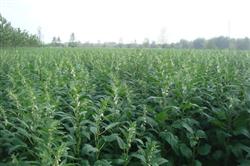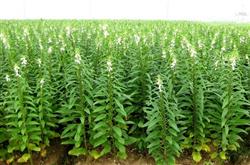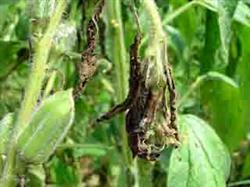How to grow white sesame seeds for high yield?

How to grow white sesame seeds for high yield? Please give guidance to plant white sesame to high yield can refer to the following planting methods: First, the selection of improved white sesame production should choose high yield and good quality, strong resistance, pure white seed Yuzhi No. 4, Yuzhi No. 8, Yuzhi No. 10 and other varieties. In order to overcome the phenomena of low yield and serious diseases and insect pests in continuous cropping of sesame seeds, repeated experiments showed that Yuzhi 4 planted in the previous year and Yuzhi 8 planted in the next year increased production by 11.6% and disease incidence decreased by 14.6% compared with Yuzhi 4 planted in the same field. Therefore, it should be strongly advocated to exchange improved seeds in the next year. II. Early sowing of sesame seeds in due time is from the end of May to the beginning of June. At this time, it is the critical period for rape and wheat to be harvested and beaten. If the weather is not good, it will directly affect the timely sowing. Therefore, the stubble shall be removed and planted one by one. The soil moisture content shall be watered before sowing to ensure that the whole seedlings are sown. Seed and soil treatment before sowing is the key to ensure full seedlings at one sowing. 50~100 ml of 50% phoxim and 150 ml of 50% carbendazim are added per mu, mixed into fried wheat bran or sesame cake of 2~2.5 kg, stewed for 1~2 hours, and then sprinkled into the field to be sown. Pesticides should not be directly mixed with sesame seeds to avoid affecting germination. Sesame seeds should be dried for 2~3 hours before sowing. If the moisture content is good, sow 250~300 grams per mu, if the moisture content is poor, sow 500 grams per mu to ensure that all seedlings are sown. When sowing, implement wide and narrow rows (40cm×20cm) or wide rows (40cm×40cm), use precision seeder to sow, and carefully harrow after sowing to preserve moisture. Third, chemical weeding Chemical weeding is divided into pre-seedling and post-seedling. Before seedling, spray 50% acetochlor 100~150 ml per mu and 40~50 kg of water within 3 days after sowing. Spray before 9 a.m. or after 5 p.m., spray evenly, do not spray again or miss spraying. If the moisture content is poor, spray more water, but dry sowing and other rainy plots, do not use pre-seedling herbicides. After seedling, during the period of 2~4 leaves of weeds, the plots dominated by monocotyledonous weeds in the field shall be sprayed with 3.5% fine and stable to 50ml mixed with 40~ 50kg water per mu, and the plots dominated by dicotyledonous weeds in the field shall be sprayed with 25% fenvalerate 60~ 75ml mixed with 40~ 50kg water per mu. The plots mixed with monocotyledonous weeds can be sprayed with the above two pesticides after mating, but the dosage shall be appropriately reduced. 4. Field management (1) seedling management, cultivation of strong seedlings, timely cultivation. Seedling is the basis of sesame high yield, early seedling, early seedling, iron stubble sowing plot should be early intertillage stubble. When sesame seedlings grow out of the first to second pairs of true leaves, carry out the first thinning, when they grow to 3 to 4 pairs of true leaves, carry out the second thinning and seedling fixation, and the seedling fixation shall be uniform. Generally, 10,000 ~ 12,000 seedlings shall be reserved per mu. It is appropriate to reserve 8,000 ~ 10,000 seedlings per mu for early-sown and high-fertility plots. At this time, it is close to the initial flowering stage. The intertillage shall be shallow. In order to improve the quality of intertillage, it is advisable to intertill in the morning of sunny days. (2) Water management. During soil preparation, 35 kg ammonium bicarbonate, 35 kg phosphate fertilizer, 12 kg potassium chloride and 35 kg plant cake were applied per mu. The seedling fertilizer is applied with fully decomposed and broken organic fertilizer before germination after sowing, 1~2 square meters per mu, urea 6 kg per mu at seedling stage, urea 8~10 kg per mu at initial flowering stage, 0.3% potassium dihydrogen phosphate, 1% urea and boron fertilizer (20g/mu) are sprayed on leaves in combination with spraying at bud emergence and capsule formation stage for 1~2 times. White sesame throughout the growth period do not drought do not water, in case of rain when the field water should be discharged in time to prevent damage. (3) The right time to top. Topping white sesame seeds 30 days before harvest can promote full sporulation and reduce nutrient consumption caused by empty shoots. 5. Insect and disease prevention White sesame has many diseases and insect pests. The prevention and control of white sesame diseases and insect pests should be based on prevention and combined with prevention and control. (1) Underground pests and seedling pests should be controlled by soil disinfection and seed treatment when white sesame seeds are sown. In addition, management should be strengthened to cultivate strong seedlings and robust plants to improve the disease resistance of sesame. (2) combined with foliar fertilizer, using chemicals to control white sesame diseases and insect pests. After seedling setting, foliar spraying with 10 ml of foliar treasure, 1.5 kg of urea, 50~100 ml of 50% carbendazim, 30 ml of 40% dimethoate emulsifiable concentrate and 50 kg of water per mu can not only control diseases and insect pests at this stage, but also play a role in topdressing; During the period from budding to flowering of white sesame, spraying 0.5 kg potassium dihydrogen phosphate, 2.5 kg urea, 15 ml foliar treasure, 150 ml 50% carbendazim colloidal suspension, 50 ml 40% dimethoate emulsifiable concentrate or methamidophos emulsifiable concentrate and 75 kg water per mu can effectively control bacterial wilt, bacterial wilt, blight, white sesame swan, blind bug and other diseases and insect pests of white sesame at this stage. After the white sesame flower is broken, spray 50% carbendazim 100ml, 20% Jinggangmycin 50g, 20% Dishasi 20~ 30ml, add water 50kg, can effectively prevent and control the disease and insect pests in the later stage of white sesame, and improve the cold resistance of white sesame. VI. Timely harvest Generally, white sesame leaves basically fall off, capsules change from green to yellow, and the lower 2~3 capsules are suitable for harvest. After harvest, they are bundled into small bundles for drying. After drying, they are bundled and patted one by one. After patting, they are re-dried, and then they can be washed again. Click for more sesame cultivation technology Click for more grain crop cultivation technology
- Prev

How to grow black sesame with high yield?
How to grow black sesame with high yield? Please introduce many varieties of black sesame. Zhongzhi 9 is the first variety selected by Oil crop Research Institute of Chinese Academy of Agricultural Sciences. The variety belongs to branching type, and the yield can reach 58.33 kg per 667 m 2 (mu). The growth period of summer sowing is 95 days. The seed coat is black and the 1000-grain weight is 2.63 grams. Oil content.
- Next

How to control white sesame bacterial wilt?
How to control white sesame bacterial wilt? Please guide white sesame bacterial wilt is very common, its yield and quality have a serious impact, its disease characteristics and control techniques are as follows: 1, the disease conditions white sesame bacterial wilt, mainly caused by excessive soil moisture, the pathogen with the diseased plant residue in the soil...
Related
- The first cup of black tea in spring, the flavor and history of tea gardens in Kenya, Africa
- The computer can not only choose potatoes, but also grow tea rice. AI will grow winter oolong tea champion.
- It is not only the inflated tea bitten by insects, but also engraved with the four seasons tea in Beipu.
- The Oriental Beauty Tea Festival in Zhuxian County takes the stage at the weekend to experience the plus-size feast of oil tea.
- & quot; Oriental Beauty Tea & Exploration of Emei in Hsinchu, the hometown of quot;
- The new variety of strawberry "Tainong 1" dessert is the first choice with mellow aroma. Crimson gorgeous
- History of Tea in Taiwan: from Wild Inner Mountain to Export Tea Garden
- Two types of Taiwan Oriental Beauty Black Tea won the British three-Star Award for Childhood Tea Xiang Zhang Jiaqi changed from pilot to champion tea maker.
- Banana species and varieties: the planting history of Taiwan Xianren banana and dwarf banana is long, is banana disease resistant?
- Coffee planting Technology: Qianjie Coffee from Seedling to harvesting

